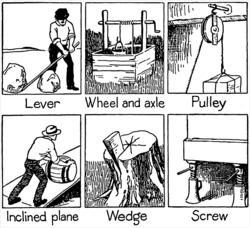
Back Einfache Maschine ALS Maquina simpla AN آلة بسيطة Arabic সৰল যন্ত্ৰ Assamese Máquina cenciella AST Прост механизъм Bulgarian সরল যন্ত্র Bengali/Bangla Jednostavne mašine BS Màquina simple Catalan مەکینەی ساکار CKB

| History of technology |
|---|
A simple machine is a mechanical device that changes the direction or magnitude of a force.[1] In general, they can be defined as the simplest mechanisms that use mechanical advantage (also called leverage) to multiply force.[2] Usually the term refers to the six classical simple machines that were defined by Renaissance scientists:[3][4][5]
A simple machine uses a single applied force to do work against a single load force. Ignoring friction losses, the work done on the load is equal to the work done by the applied force. The machine can increase the amount of the output force, at the cost of a proportional decrease in the distance moved by the load. The ratio of the output to the applied force is called the mechanical advantage.
Simple machines can be regarded as the elementary "building blocks" of which all more complicated machines (sometimes called "compound machines"[6][7]) are composed.[2][8] For example, wheels, levers, and pulleys are all used in the mechanism of a bicycle.[9][10] The mechanical advantage of a compound machine is just the product of the mechanical advantages of the simple machines of which it is composed.
Although they continue to be of great importance in mechanics and applied science, modern mechanics has moved beyond the view of the simple machines as the ultimate building blocks of which all machines are composed, which arose in the Renaissance as a neoclassical amplification of ancient Greek texts. The great variety and sophistication of modern machine linkages, which arose during the Industrial Revolution, is inadequately described by these six simple categories. Various post-Renaissance authors have compiled expanded lists of "simple machines", often using terms like basic machines,[9] compound machines,[6] or machine elements to distinguish them from the classical simple machines above. By the late 1800s, Franz Reuleaux[11] had identified hundreds of machine elements, calling them simple machines.[12] Modern machine theory analyzes machines as kinematic chains composed of elementary linkages called kinematic pairs.
- ^ Paul, Akshoy; Roy, Pijush; Mukherjee, Sanchayan (2005), Mechanical sciences: engineering mechanics and strength of materials, Prentice Hall of India, p. 215, ISBN 978-81-203-2611-8.
- ^ a b Asimov, Isaac (1988), Understanding Physics, New York: Barnes & Noble, p. 88, ISBN 978-0-88029-251-1.
- ^ Anderson, William Ballantyne (1914). Physics for Technical Students: Mechanics and Heat. New York: McGraw Hill. p. 112. Retrieved May 11, 2008.
- ^ "Mechanics". Encyclopædia Britannica. Vol. 3. John Donaldson. 1773. p. 44. Retrieved April 5, 2020.
- ^ Morris, Christopher G. (1992). Academic Press Dictionary of Science and Technology. Gulf Professional Publishing. p. 1993. ISBN 978-0122004001.
- ^ a b Compound machines, University of Virginia Physics Department, retrieved June 11, 2010.
- ^ Usher, Abbott Payson (1988). A History of Mechanical Inventions. US: Courier Dover Publications. p. 98. ISBN 978-0-486-25593-4.
- ^ Wallenstein, Andrew (June 2002). "Foundations of cognitive support: Toward abstract patterns of usefulness". Proceedings of the 9th Annual Workshop on the Design, Specification, and Verification of Interactive Systems. Springer. p. 136. ISBN 978-3540002666. Retrieved May 21, 2008.
- ^ a b Prater, Edward L. (1994), Basic machines (PDF), U.S. Navy Naval Education and Training Professional Development and Technology Center, NAVEDTRA 14037.
- ^ Reuleaux, F. (1963) [1876], The kinematics of machinery (translated and annotated by A.B.W. Kennedy), New York: reprinted by Dover.
- ^ Cornell University, Reuleaux Collection of Mechanisms and Machines at Cornell University, Cornell University.